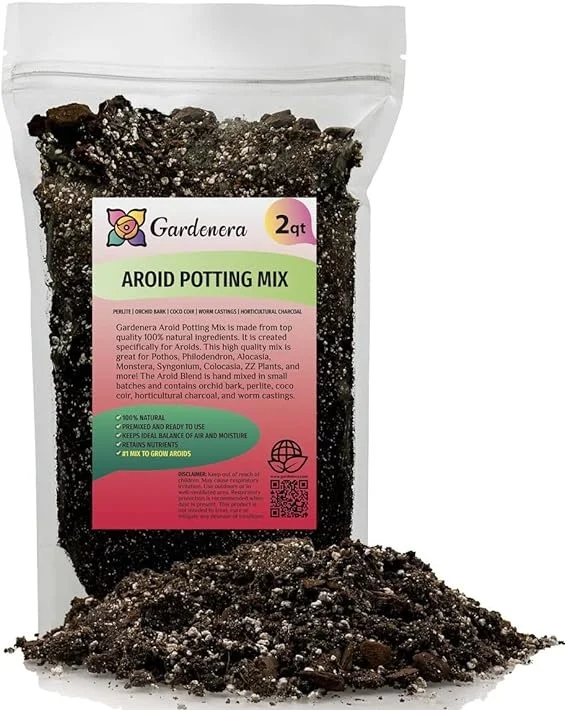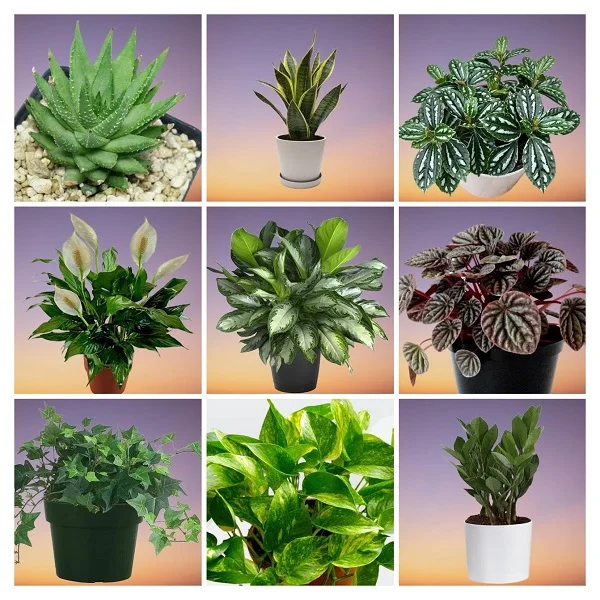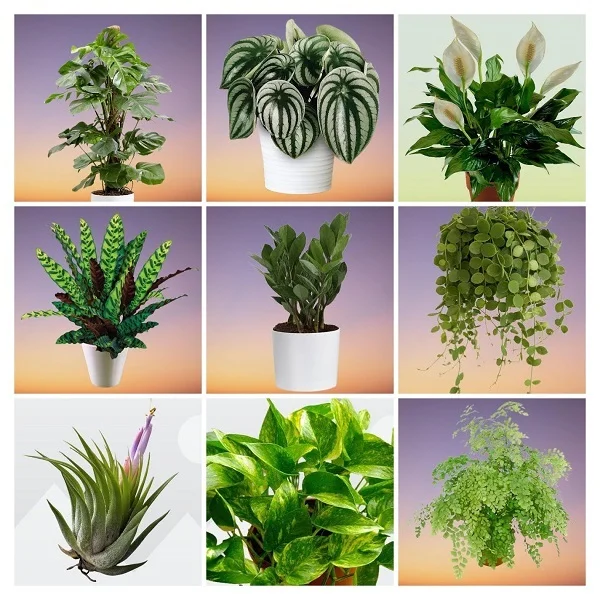Scindapsus aureus (Devil's Ivy) Care Indoors, Propagation, Problems and Solutions
Last updated on
Some links in this post may be affiliate links
Scindapsus aureus (Pothos) grow best in medium to bright indirect light away from direct sunlight, moderately warm and humid conditions and moderately moist, rich, well-drained, Pothos potting soil coupled with monthly feeding in the growing season.
Scindapsus aureus also called Devil's Ivy, Devil's Vine or Money Plant are popular Pothos plants with air purifying properties and are easy to grow even for the beginner.
Scindapsus aureus also called Epipremnum aureum is one of the hard to kill plants that easily adapt to a wide range of growing conditions.
Pothos Plants are low maintenance plants and are generally pest resistant. If kept away from drafts, direct sunlight and with moderate watering, they will thrive.
Devil's Ivy are fast-growing plants reaching up to 6 feet or more under good conditions and can be treated as a trailer or climber.
Their aerial roots need to be provided with support; a moss stick is ideal to provide support and feeding. The stems can also be allowed to trail from a hanging basket, a pedestal or a wall display. It is one of the best plants for hanging baskets.
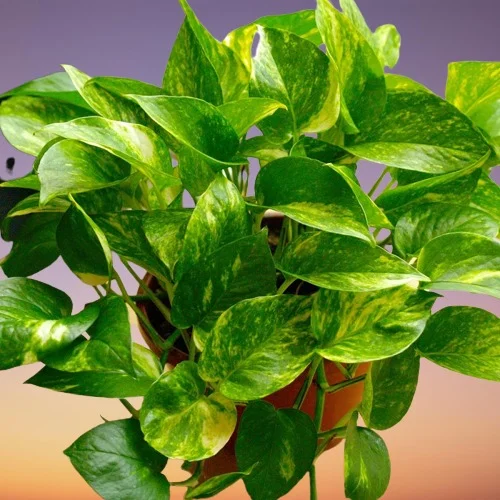
Botanical name: Scindapsus aureus
Synonym: Epipremnum aureum
Family: Araceae
Common names: Pothos, Devil's Ivy, Devil's Vine, Money Plant
Origin
Scindapsus aureus are native to Mo'orea in the Society Islands of French Polynesia but has also become naturalised in tropical and sub-tropical forests worldwide.
Varieties
Epipremnum aureum has many varieties which include;
Epipremnum aureum 'Neon' (Neon Pothos)
Epipremnum aureum 'Marble Queen' (Marble Queen Pothos)
Epipremnum aureum 'Manjula' (Manjula Pothos)
Epipremnum aureum 'Pearls and Jade' (Pearls & Jade Pothos)
Epipremnum aureum 'N'Joy' (N'Joy Pothos)
Epipremnum aureum 'Snow Queen' (Snow Queen Pothos)
Epipremnum aureum 'Jade' (Jade Pothos) among others.
Air Cleaning
According to the NASA Clean Air Study, Scindapsus aureus was found to be one of the best air-cleaning plants and gets rid of xylene, toulene, benzene, formaldehyde and ammonia from indoor air.
Is Scindapsus aureus toxic to pets?
Devil's Ivy are toxic to both humans and pets according to ASPCA. They contain Calcium oxalate. If ingested it causes burning and swelling in the mouth and throat, vomiting, diarrhea and abdominal pains. Keep the plants from the reach of children and pets to avoid any mishap. They are toxic to cats, dogs, horses and other pets.
Why grow Scindapsus aureus indoors?
- Low maintenance: It tolerates neglect and still grows well.
- Air-purifying: It filters toxins from indoor air, improving air quality.
- Versatile: Can trail beautifully or be trained to climb.
- Easy to propagate: It is effortlessy propagated through stem cuttings.
- Adaptable: Thrives in various light conditions.
- Drought-Tolerant: Can survive low water conditions.
- Fast growing: Under right conditions it grows rapidly.
Where to Buy
Pothos are a great addition to your collection to elevate your home ambiance. You may obtain these plants online from Amazon (Link to Amazon).
Scindapsus aureus Care Indoors
Not only does it purify indoor air, but Scindapsus aureus also thrives in various lighting conditions and requires minimal care. Whether you are a beginner or an experienced plant lover, this guide will help you keep your Scindapsus aureus healthy and thriving.
Scindapsus aureus (Pothos) flourish in medium to bright indirect light, moderate warmth of 18-290C, humidity of 50-55% and moderately moist, rich, well-drained, Pothos potting soil coupled with monthly feeding in the growing season.
Pothos Plant requires regular pruning to keep it neat, to promote a bushy growth and to rejuvenate growth. Repotting is needed only when the plant becomes pot-bound. Keep reading for more on these growing conditions and how to achieve them.
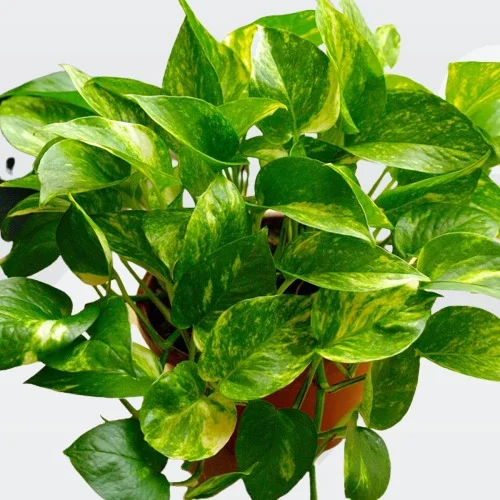
Watering
Water Scindapsus aureus liberally during the growing season while allowing the top 2-3 inches of soil to dry out between waterings to keep the soil moderately moist. Overwatering results in rotting stems and yellow leaves.
Cut down on watering during the cold season to keep the soil slightly moist as growth is minimal at this time. Do not allow the soil to dry out completely to avoid wilting and drooping leaves.
Make sure that the pot has a drainage hole to prevent the soil from getting soggy soil as it can lead to root-rot.
Temperature and Humidity
Scindapsus aureus thrives in an average warmth of 18-290C and a minimum of 120C. A room temperature that is comfortable for you is ideal for Pothos. Keep it away from cold drafts as they can cause sudden changes in the temperature which lead to leaf drop.
Devil's Ivy have no need for extra humidity. Average room humidity of 50-55% is ideal for these plants. However, if the air is too dry the plant will respond with brown-black and shrivelled leaf tips. Set the pot on a wet pebble tray or use a cool mist humidifier to raise humidity.
Regularly damp-wipe the leaves with a soft cloth to get rid of dust and discourage pest infestation. Make sure that there is good air circulation to prevent fungal diseases.
Light Requirements
Pothos grow best in medium to bright indirect light (filtered light). Keep it away from hot direct sunlight to avoid scorching the leaves, causing brown edges.
They can tolerate lower light but the variegation will fade in poor light. The more variegated types require more light than the all-green varieties.
Too little light will result in leggy growth with long gaps between leaves. Move it to a brighter spot or instal a grow light if the natural lighting is not adequate.
Regularly rotate the pot to ensure that the plant receives light on all sides for a balanced growth and to prevent leggy growth.
Potting Mix
Devil's Ivy soil should be rich in organic matter and free-draining to prevent it from getting soggy while providing the required nutrients. Most potting mixes designed for Pothos and those designed for aroids are ideal for this plant. Check out these 8 potting soil mixes for Pothos.
Fertilizer (Feeding)
Feed your Scindapsus aureus every 4 weeks during the growing period with a balanced, liquid fertilizer for lush growth. Stop feeding in the cold season as growth at this time is minimal and feeding at this time may lead to fertilizer burn.
Take care not to over-fertilize as it can lead to salt buildup, which causes leaf browning. Flush the soil occasionally with water to prevent this.
Repotting
Repot your Devil's Ivy during the growing season only when the plant has become pot-bound. Use a rich, free-draining soil and a pot one size larger than the current one. Ensure the pot has a drainage hole to prevent the soil from getting soggy as it can lead to root-rot. Take a look at these ceramic pots with drainage holes and saucer on Amazon.
Pruning
Pruning Scindapsus aureus involves frequent removal of any dead foliage. Pinch off the growing tips to encourage bushyness and prevent the plant from becoming leggy.
Cutback the stems at the beginning of the growing season when they become straggly to rejuvenate growth. The foliage emanating from the pruning can be used to propagate new plants.
Propagation: How to multiply Scindapsus aureus
Scindapsus aureus propagation is done at the beginning of the growing season from stem cuttings. The cuttings can be rooted in soil or in water.
Pothos propagation from stem cuttings in soil
Take a 4-6 inches stem cutting from a healthy Devil's Ivy. Ensure the cutting has at least two leaf nodes and some aerial roots.
Strip off the lower leaves and insert the cutting in moist rooting soil, ensure at least one leaf node together with the aerial roots are covered under soil.
To hasten rooting , cover the set up with polythene to create a greenhouse effect.
Place the set up in a warm, well-lit place and maintain the soil moist through out until roots have developed.
Rooting should take about 2-3 weeks and the new Pothos will be ready to be transplanted in about 2-3 months.
Pothos propagation from stem cuttings in water
Take a 4-6 inches stem cutting from a healthy Pothos plant. Ensure the cutting has at least 2-3 leaf nodes and some aerial roots.
Strip off the lower leaves and place it in a jar of plain water, ensure at least one leaf node is covered in water as well as the aerial roots.
Place the set up in a well-lit spot and change the water every once 5-7 days. Rooting Pothos in water should take about 3-4 weeks. When the roots are about 2 inches long, start acclimating them to grow in soil.
Acclimating the roots to grow in soil entails adding a little soil daily into the rooting jar over a period of time until when there is more soil than water in the rooting jar.
The new Devil's Ivy is ready for transplanting when the roots have grown to about 4 inches long after which you can begin routine care.

Scindapsus aureus Common Problems
Pothos Plant common problems include yellow leaves, drooping leaves, leggy growth, brown leaf edges and spots, curled and shrivelled leaves, diseases and pests among others. Keep reading for more details on these problems and how to fix them.
Yellow leaves
Pothos yellow leaves are due to poor lighting, incorrect watering, wrong temperatures, improper feeding, poor soil quality, being pot-bound, diseases and pests among others.
Check out these 12 Reasons Pothos Plant Leaves are Turning Yellow and How to Fix Them.
Drooping leaves
Drooping leaves in Scindapsus aureus are caused by underwatering. Water thoroughly and the plant should perk up. Keep the soil moist through out and do not allow it to dry out completely.
Leggy growth
Leggy growth in Pothos is due to low light. Move the plant to a brighter spot or use a grow light if you do not enough light in your home.
Pests
Common pests in Pothos pests are spider mites and mealy bugs. Isolate the affected plant to prevent spread to other plants and treat it with horticultural oil or insecticidal soap as per the manufacturer's instructions.
Diseases
Pothos are prone to root-rot which is promoted by soggy soil. The disease is characterized by yellow leaves, leaf drop and rotting stems. Always, ensure that the soil is free-draining and that the pot has a drainage hole to prevent the soil from getting soggy.
Brown leaf edges and brown leaf spots
Brown leaf edges and brown leaf spots in Pothos are caused by underwatering. Water when the top 2-3 inches of soil dry out. Never allow the root ball to dry out completely. Read more on how to water houseplants the correct way.
Curled, limp leaves and rotting stems
Curled, limp leaves and rotting stems in Scindapsus aureus are caused by sudden changes in temperature due to drafts. Keep the plants away from cold drafts to maintain an average warmth of 18-290C. Check out this guide on understanding temperature for houseplants.
Brown-black, shrivelled leaf tips
Brown-black, shrivelled leaf tips in Pothos are caused by four possible reasons. One possible reason is too low humidity. To elevate humidity, set the pot on a wet pebble tray or use a humidifier. You may also grow the plant in a well-lit bathroom or other humid areas in the home.
The second possible reason for brown-black, shrivelled leaf tips in Pothos is soggy soil. Repot in fresh soil. Ensure the soil is draining properly and the pot has a drainage hole. In addition, do not leave water standing on the saucer after watering; discard any water that remains on the saucer after watering.
The third possible reason for brown-black, shrivelled leaf tips in Scindapsus aureus is underwatering. Water the plant thoroughly until water drips through the drainage holes when the top 2-3 inches of soil dry out; avoid delayed watering.
The fourth possible reason for brown-black, shrivelled leaf tips in Pothos is overfeeding or accumulation of chemicals in the soil. Regularly flush out any excess chemicals from the soil.
Conclusion
Scindapsus aureus (Pothos) is a low-maintenance, fast-growing, and visually stunning houseplant. Whether you let it trail in a hanging basket or train it to climb, this plant is adaptable and perfect for any indoor space. By providing proper lighting, watering, and occasional pruning, you can enjoy a lush and healthy Golden Pothos for years.
Frequently Asked Questions
1. How much sunlight does Scindapsus aureus need?
Scindapsus aureus thrives in bright, indirect light but can tolerate low light but growth will be slower.
2. How often should I water Golden Pothos?
Water Pothos when the top 1–2 inches of soil dry out. Avoid overwatering.
3. Why are my Pothos leaves turning yellow?
Yellowing is often caused by overwatering or poor drainage. Let the soil dry out before watering again.
4. Can Scindapsus aureus grow in water permanently?
Yes, Scindapsus aureus can survive in water indefinitely, but adding nutrients is necessary for long-term health.
5. Is Scindapsus aureus toxic to pets?
Yes, Scindapsus aureus is toxic to cats and dogs if ingested. Keep it out of reach of pets
6. How fast does Golden Pothos grow?
In ideal conditions, Golden Pothos grows 6–12 inches per month.
7. Can I train Scindapsus aureus to climb?
Yes, use a moss pole or trellis to support upward growth.
You liked it? Share on social media.
Related Content
Amazon Associates Disclosure
Homeplantsguide.com is a participant in the Amazon Services LLC Associates Program, an affiliate advertising program designed to provide a means for sites to earn advertising fees by advertising and linking to amazon.com.
